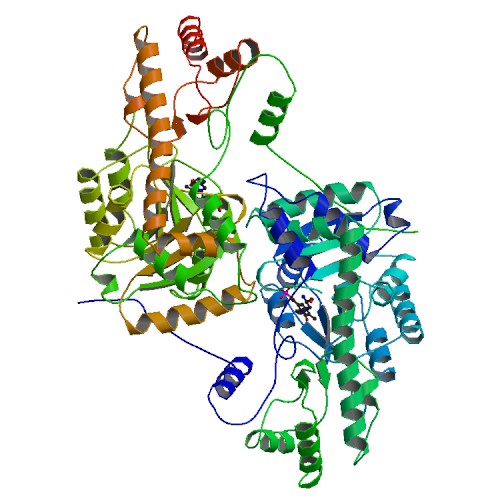GOT1
| Glutamic-oxaloacetic transaminase 1, soluble (aspartate aminotransferase 1) | |||||||||||||
|---|---|---|---|---|---|---|---|---|---|---|---|---|---|
 PDB rendering based on 1ajr. | |||||||||||||
| |||||||||||||
| Identifiers | |||||||||||||
| Symbols | GOT1 ; GIG18 | ||||||||||||
| External IDs | Template:OMIM5 Template:MGI HomoloGene: 1571 | ||||||||||||
| |||||||||||||
| RNA expression pattern | |||||||||||||
 | |||||||||||||
| More reference expression data | |||||||||||||
| Orthologs | |||||||||||||
| Template:GNF Ortholog box | |||||||||||||
| Species | Human | Mouse | |||||||||||
| Entrez | n/a | n/a | |||||||||||
| Ensembl | n/a | n/a | |||||||||||
| UniProt | n/a | n/a | |||||||||||
| RefSeq (mRNA) | n/a | n/a | |||||||||||
| RefSeq (protein) | n/a | n/a | |||||||||||
| Location (UCSC) | n/a | n/a | |||||||||||
| PubMed search | n/a | n/a | |||||||||||
Glutamic-oxaloacetic transaminase 1, soluble (aspartate aminotransferase 1), also known as GOT1, is a human gene.[1]
Glutamic-oxaloacetic transaminase is a pyridoxal phosphate-dependent enzyme which exists in cytoplasmic and mitochondrial forms, GOT1 and GOT2, respectively. GOT plays a role in amino acid metabolism and the urea and tricarboxylic acid cycles. The two enzymes are homodimeric and show close homology.[1]
References
Further reading
- Panteghini M (1990). "Aspartate aminotransferase isoenzymes". Clin. Biochem. 23 (4): 311–9. PMID 2225456.
- Doonan S, Barra D, Bossa F (1985). "Structural and genetic relationships between cytosolic and mitochondrial isoenzymes". Int. J. Biochem. 16 (12): 1193–9. PMID 6397370.
- Kamei S, Ohkubo A, Yamanaka M (1979). "Apoenzyme of aspartate aminotransferase isozymes in serum and its diagnostic usefullness for hepatic diseases". Clin. Chim. Acta. 96 (1–2): 97–105. PMID 225064.
- Bousquet-Lemercier B, Pol S, Pavé-Preux M; et al. (1990). "Properties of human liver cytosolic aspartate aminotransferase mRNAs generated by alternative polyadenylation site selection". Biochemistry. 29 (22): 5293–9. PMID 1974457.
- Doyle JM, Schininà ME, Bossa F, Doonan S (1990). "The amino acid sequence of cytosolic aspartate aminotransferase from human liver". Biochem. J. 270 (3): 651–7. PMID 2241899.
- Pol S, Bousquet-Lemercier B, Pavé-Preux M; et al. (1989). "Chromosomal localization of human aspartate aminotransferase genes by in situ hybridization". Hum. Genet. 83 (2): 159–64. PMID 2777255.
- Pol S, Bousquet-Lemercier B, Pave-Preux M; et al. (1989). "Nucleotide sequence and tissue distribution of the human mitochondrial aspartate aminotransferase mRNA". Biochem. Biophys. Res. Commun. 157 (3): 1309–15. PMID 3207426.
- Andersson B, Wentland MA, Ricafrente JY; et al. (1996). "A "double adaptor" method for improved shotgun library construction". Anal. Biochem. 236 (1): 107–13. doi:10.1006/abio.1996.0138. PMID 8619474.
- Yu W, Andersson B, Worley KC; et al. (1997). "Large-scale concatenation cDNA sequencing". Genome Res. 7 (4): 353–8. PMID 9110174.
- Wang CY, Huang YQ, Shi JD; et al. (1999). "Genetic homogeneity, high-resolution mapping, and mutation analysis of the urofacial (Ochoa) syndrome and exclusion of the glutamate oxaloacetate transaminase gene (GOT1) in the critical region as the disease gene". Am. J. Med. Genet. 84 (5): 454–9. PMID 10360399.
- Strausberg RL, Feingold EA, Grouse LH; et al. (2003). "Generation and initial analysis of more than 15,000 full-length human and mouse cDNA sequences". Proc. Natl. Acad. Sci. U.S.A. 99 (26): 16899–903. doi:10.1073/pnas.242603899. PMID 12477932.
- Miyake Y, Eguchi H, Shinchi K; et al. (2003). "Glucose intolerance and serum aminotransferase activities in Japanese men". J. Hepatol. 38 (1): 18–23. PMID 12480555.
- Deloukas P, Earthrowl ME, Grafham DV; et al. (2004). "The DNA sequence and comparative analysis of human chromosome 10". Nature. 429 (6990): 375–81. doi:10.1038/nature02462. PMID 15164054.
- Wu KL, Lu SN, Changchien CS; et al. (2004). "Sequential changes of serum aminotransferase levels in patients with severe acute respiratory syndrome". Am. J. Trop. Med. Hyg. 71 (2): 125–8. PMID 15306699.
- Gerhard DS, Wagner L, Feingold EA; et al. (2004). "The status, quality, and expansion of the NIH full-length cDNA project: the Mammalian Gene Collection (MGC)". Genome Res. 14 (10B): 2121–7. doi:10.1101/gr.2596504. PMID 15489334.
- Totan A, Greabu M, Totan C, Spinu T (2006). "Salivary aspartate aminotransferase, alanine aminotransferase and alkaline phosphatase: possible markers in periodontal diseases?". Clin. Chem. Lab. Med. 44 (5): 612–5. doi:10.1515/CCLM.2006.096. PMID 16681433.
- Dubern B, Girardet JP, Tounian P (2007). "Insulin resistance and ferritin as major determinants of abnormal serum aminotransferase in severely obese children". International journal of pediatric obesity : IJPO : an official journal of the International Association for the Study of Obesity. 1 (2): 77–82. PMID 17907318.
| This protein-related article is a stub. You can help Wikipedia by expanding it. |